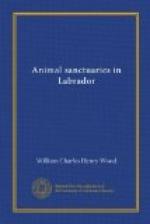further them. But unless we make these sanctuaries
soon we shall be infamous forever, as the one generation
which defrauded posterity of all the preservable wild
life that Nature took a million years to evolve into
its present beautiful perfection. Only a certain
amount of animal life can exist in a certain area.
The surplus must go outside. So sanctuaries are
more than wild “zoos”, they are overflowing
reservoirs, fed by their own springs, and feeding streams
of life at every outlet. They serve not only
those interested in animal life, but those legitimately
interested in animal death, for business, sport or
food. I might mention many instances of successful
sanctuaries, permanent or temporary, absolute or modified—the
Algonquin, Rocky Mountains, Yoho, Glacier, Jasper
and Laurentides in Canada; the Yellowstone, Yosemite,
Grand Canon, Olympus and Superior in the United States;
with the sea-lions of California, the wonderful revival
of ibex in Spain and deer in Maine and New Brunswick,
the great preserves in Uganda, India and Ceylon, the
selective work of Baron von Berlepsch in Germany,
the curious result of taboo protection up the Nelson
river, and the effects on seafowl in cases as far apart
in time and space as the guano islands under the Incas
of Peru, Gardiner island in the United States or the
Bass rock off the coast of Scotland.
Yet I do not ignore the difficulties. First,
there is the universal difficulty of introducing or
enforcing laws where there have been no operative
laws before. Next, there is the difficulty of
arousing public opinion on any subject, however worthy,
which requires both insight and foresight. Then,
we must remember that protected species increasing
beyond their special means of subsistence have to seek
other kinds of food, sometimes with unfortunate results.
And then there are the several special difficulties
connected with Labrador. There are three British
governments concerned—Newfoundland, the
Dominion and the province of Quebec. There are
French and American fishermen along the shore.
The proper protection of some migratory species will
require co-operation with the United States, perhaps
with Mexico and South America for certain birds, and
even with Denmark for the Greenland seal. Then,
there are the Indians, the whole trade in animal products,
the necessity of not interfering with any legitimate
development, and the question of immediate expense,
however small, for a deferred benefit, however great
and near at hand. And, finally, we must remember
that scientific knowledge is not by any means adequate
to deal with all the factors of the problem at once.
LABRADOR




